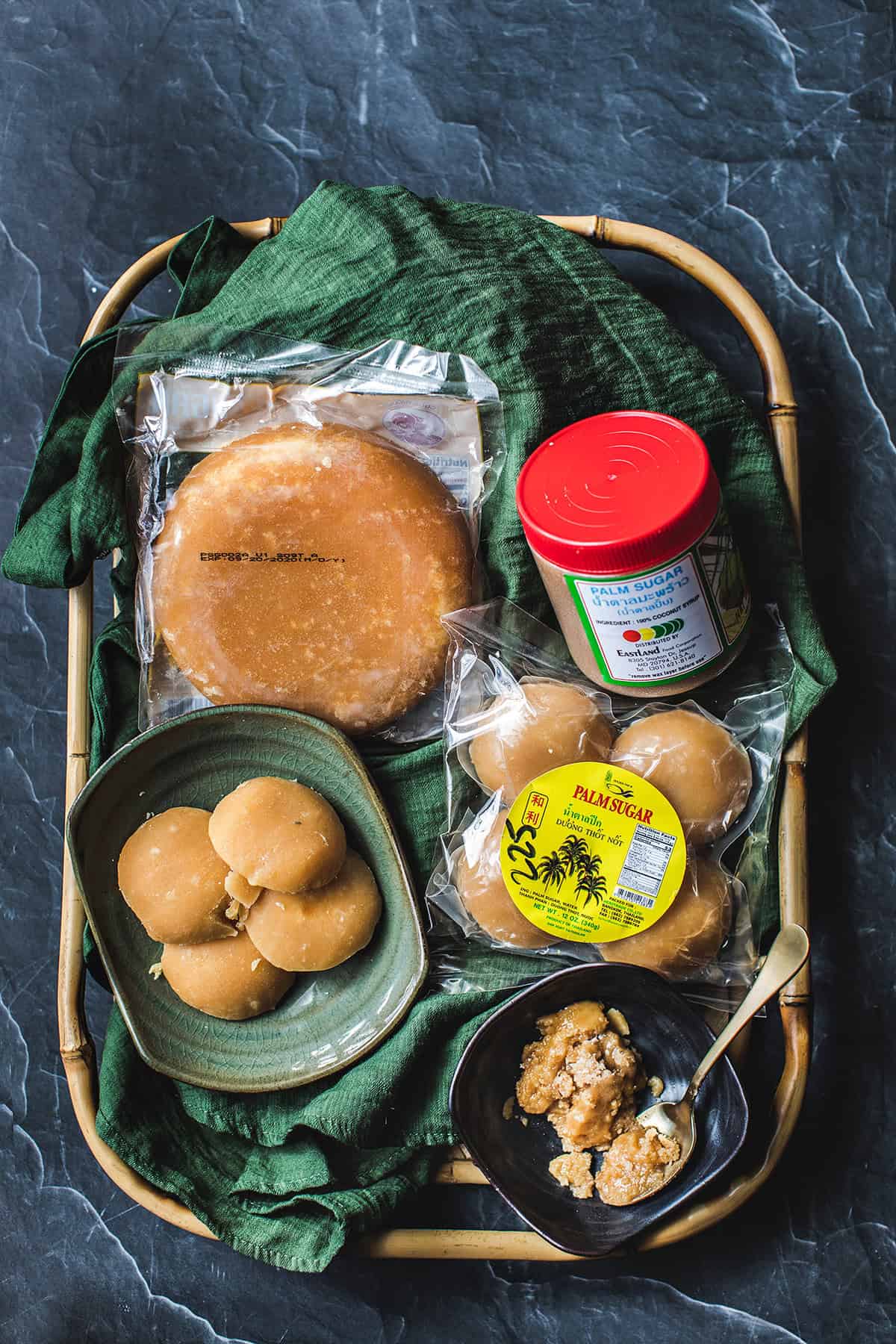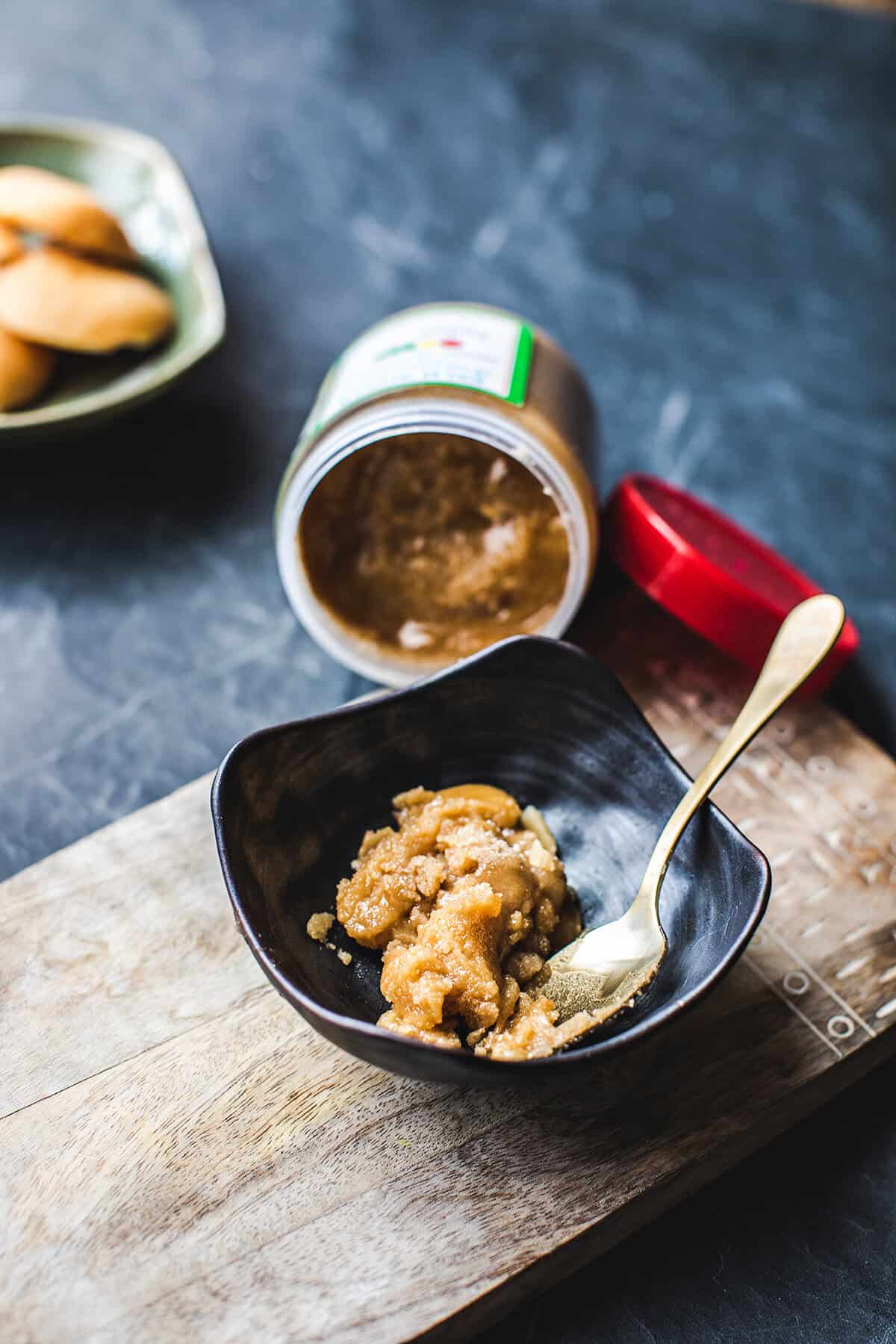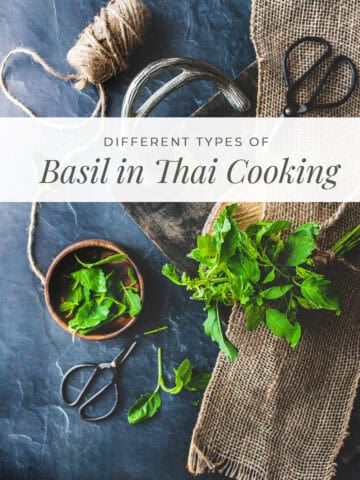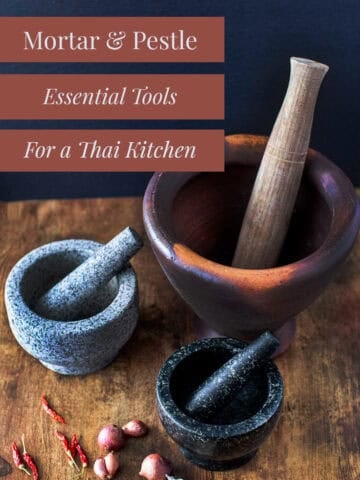Palm sugar, or Nam Tan Peep, is common in Thai cooking. The unique caramel-like flavor and texture of palm sugar make it a delicious addition to add to your pantry for your Thai cooking. Let's learn about what is palm sugar (its substitutes and uses in Thai cooking)!

Palm sugar is commonly produced in tropical regions such as Southeast Asia, including countries like Indonesia, Thailand, and the Philippines. It is widely used in these regions as a sweetener in various culinary savory dishes, desserts, and beverages.
The most popular Thai recipe using palm sugar is The addictive sweet umami sauce. Other Thai palm sugar recipes are Homemade Pad Thai sauce, Pad Mee Korat, Nam Jim Jaoew, and Son-in-law's eggs recipe.
Jump to:
- What is palm sugar? (น้ำตาลปึก, น้ำตาลปาล์ม or น้ำตาลปี๊บ)
- What does palm sugar taste like?
- How is palm sugar made?
- How to use palm sugar
- Is coconut sugar the same as palm sugar?
- Is palm sugar different than white sugar?
- Is palm sugar healthier than white sugar?
- Is palm sugar and brown sugar the same?
- Is jaggery the same as palm sugar?
- What is Gula Melaka?
- What is coconut sap sugar?
- The best substitutes for palm sugar
- Qualities of palm sugar
- Where to buy palm sugar?
- What are the health benefits of palm sugar?
- How to store palm sugar
- What Thai recipes call for palm sugar?
- Thai Kitchen Resources
- Frequently asked questions
- Final words on palm sugar
- More Helpful Thai Cooking Resources
What is palm sugar? (น้ำตาลปึก, น้ำตาลปาล์ม or น้ำตาลปี๊บ)
Palm sugar comes in many shapes, sizes, textures, and colors. You will find information and photos of different palm sugar types I use for Thai recipes on this blog!

Palm sugar, or Nam Tan Peep, is a kind of sugar that comes from the sap of palm trees and their flowers. It's different from white sugar because it isn't processed as much, so it keeps more of its natural nutrients and tastes similar to caramel. It's a common ingredient used as a sweetener in Asian cooking, especially in Thai food. It gives dishes like pad Thai and curries a yummy nutty caramel taste.
What does palm sugar taste like?
If you were to mix brown sugar with honey, water, and white sugar, then roll that up into a hardened ball, you would get a feel for the texture of palm sugar. The taste, though, is caramel-like with a distinct palm flavor that is light and sweet but not as bold as granulated white sugar.
It’s quite a gentle sugary flavor that doesn’t overpower a dish too much, especially when used with other strong flavors like fish sauce and fresh lime juice.
How is palm sugar made?

The palm sugar comes from the sap of specific coconut palm trees. Once the sap is extracted then boiled to remove water, help release flavors, and thicken into a syrup-like texture. Once cooled, the syrup turns into sugar crystals. Finally, the palm sugar syrup is shaped into different mold sizes and packaged for consumer sale.
How to use palm sugar
Palm sugar is a great ingredient that can make sweet and savory recipes taste better. You can use it in Thai curries, stir-fries, sauces, and desserts. It can even be eaten as a plain sweet treat like candy! In moderation, of course! There are lots of delicious things you can make with palm sugar.
Is coconut sugar the same as palm sugar?
It's easy to get the two types of palm sugars confused. However, they are not the same. They come from two varieties of palm trees, date palm, and coconut palm. Let's dig in a bit to understand the differences between the two. The process of palm sugar production of each is also slightly different.
Is palm sugar different than white sugar?
Palm sugar and white sugar differ in their sources and processing methods. Palm sugar is made from the sap of palm trees, while white sugar is typically derived from sugarcane or sugar beets. Its rich nutty caramel flavor adds a delightful taste to various dishes, making it a versatile and flavorful choice for sweet and savory recipes.
Is palm sugar healthier than white sugar?
Palm sugar is generally healthier than white sugar because it contains some minerals and vitamins. However, both types of sugar should be consumed in moderation as excessive sugar intake can negatively impact health.
Is palm sugar and brown sugar the same?
Palm sugar and brown sugar are not the same. As mentioned above, palm sugar is made from the sap of a specific type of coconut palm tree. In comparison, brown sugar is usually made from sugar cane, mixed with molasses for the brown color and flavor, with white sugar added to complete the process.
Is jaggery the same as palm sugar?
Jaggery, another type of unrefined sugar, is made from sugar cane or date palm sap. It has a flavor similar to palm sugar with a dark brown color and a stronger caramel-like taste and fragrance. The way it's made and the ingredients used are different, which gives it a different taste and texture. However, jaggery can be used instead of palm sugar in some recipes.
What is Gula Melaka?
Gula Melaka is also palm sugar, but it is darker in color with a deeper toffee-like flavor. Gula Melaka is more popular in Southeast Asian countries like Indonesia, Malaysia, and Singapore than in Thailand.
What is coconut sap sugar?
Coconut sap sugar is the same as coconut sugar. The sap refers to the source of the sugar, the sap of the palm trees where the nectar is collected, processed, and made into coconut sugar used in cooking.
1. Coconut sugar
Coconut sugar comes from the sap of date palm trees. They are sometimes called date palm sugar. The texture of the sugar crystals is coarse with a brown color. It's a popular sugar because it has a lower glycemic index than regular sugar and has more vitamins and fiber. It's sometimes called coconut palm sugar, making it even more confusing. (:
Here is how you tell the difference. Coconut sugar looks similar to cane sugar but has a darker brown color. And coconut sugar is never sold in pugs shaped form or as a paste-like texture. Coconut sugar is also more readily available in your regular grocery stores.
2. Palm sugar
Palm sugar, used in my Thai recipes and this blog post, comes from the nectar of coconut palm flowers. It has a light brown color that comes in various shapes and textures. It has a mild caramel flavor, so it's often used in Asian, Middle Eastern, and North African cooking. This is the palm sugar that I use for my Thai recipes. You can find palm sugar in most Asian markets.
The best substitutes for palm sugar

If you don't have palm sugar, you can substitute other sweeteners. It also depends on what recipes are used. Below are suggestions for comparable alternative sugars. Understand, though, that each type of sugar will have different flavors, colors, textures, and aromas when used in recipes.
- Brown sugar. The best substitute for palm sugar is light brown sugar. Dark brown sugar is next for best substitutes, but it has a deeper molasses flavor that can slightly affect the taste of a recipe. These two types of brown sugar are the most popular substitutes in my own kitchen.
- Coconut sugar. Coconut sugar comes from coconut trees and works fine as a palm sugar alternative. Use coconut sugar in stir-fries, curries, and sauces in recipes like Pad Mee, Thai red curry, and mixed vegetable stir fry.
- Cane Sugar. Cane sugar, made from sugarcane plants, is used like white or coconut sugar, though cane sugar is a sweetener than coconut sugar and can be used in recipes where white sugar is called for.
- White granulated sugar. White sugar is made from sugarcane or sugar beets and processed into white table sugar.
- Monk fruit sugar. Another natural plant-based sugar is one of my favorites in Thai cooking when I want to reduce the number of calories.
- Maple sugar. Maple sugar is similar to coconut sugar but has a maple flavor that might make the dish taste slightly different when cooking.
- Honey. Honey is a good choice in Thai recipes like Nam Jim Jaeow, Prik Khing with shrimp, and easy chicken wing recipes.
- Agave. Agave nectar is a good alternative to sugar in recipes like Som Tum and Nam Jim Jaeow. Raw Agave Nectar can also be used. This sweet sticky sugar is my go-to sweetener when I want a healthier option in my cooking.
Qualities of palm sugar
Yes, there are different types of palm sugar with different qualities. The better quality palm sugar is usually made from specific types of palm trees, like the Palmyra palm or coconut palm. It goes through less processing, so it tastes better and is purer.
Beware that some brands of palm sugar have added white sugar to it to intensify the sweetness and save money on the hard-to-harvest palm sugar nectar. To tell if palm sugar is not 100% pure palm sugar by the white chalkiness of palm sugar discs. The sugar pugs are also lighter in color and have a dryer feel to them.
Good quality palm sugar tastes like caramel. It's usually sold in blocks or discs. Lower-quality palm sugar is lighter in color and doesn't taste as good. It might be a liquid or mixed with other sweeteners.
Where to buy palm sugar?
You can buy palm sugar at various places. You can find it at most Asian food stores and any international grocery store. You can also buy different brands of palm sugar online as well. Eastland palm sugar, Dragon fly palm sugar paste, JHC Palm sugar (in discs), and Four Elephant palm sugar. (Affiliate links).
What are the health benefits of palm sugar?
- Raw palm sugar nectar is rich in vitamins and minerals such as iron, magnesium, and potassium. These nutrients are essential for maintaining healthy blood circulation, promoting strong bones, and supporting proper muscle function. These health benefits make palm sugar a better option than white sugar.
- Palm sugar has a low glycemic index, which releases sugar into the bloodstream more slowly than refined white sugar. This can help regulate blood sugar levels and prevent sudden spikes, making it a better option for people with diabetes or those looking to manage their weight.
- Palm sugar nectar contains antioxidants that can help fight against free radicals, reducing the risk of chronic diseases like heart disease and certain types of cancer.
How to store palm sugar
If you want palm sugar to last long, keep it in a cool and dry place, like in a closed container. If it gets wet, it might get sticky or clump together. You can use a fork to break it apart or grate it to make it easier.
What Thai recipes call for palm sugar?
- Authentic homemade Pad Thai sacue
- Authentic Shrimp Pad Thai
- Thai Drunken Noodles
- Pad see eww
- Moo Ping, Thai grilled pork skewers

Read these detailed and helpful blog posts to learn more about important Thai ingredients.
Thai Kitchen Resources
- What is tamarind and how to use it
- Fried garlic and oil
- Crispy fried shallots
- Kaffir lime leaves and substitutes
- Lemongrass
- Galangal, what it is, and how to use it.
Frequently asked questions
Table sugar and palm sugar are different. White table sugar or granulated sugar is made from sugarcane or sugar beets. These are then turned into raw sugar, cubes of sugar, powdered sugar, or brown sugar. Palm sugar is made from the sap of the coconut palm tree and processed into pugs or paste for cooking.
You can, but the flavors and texture will not be the same. Palm sugar has a lighter taste and texture than coconut sugar. Both are sweeteners, but coconut sugar is not used in Thai cuisine.
Palm sugar is a natural sugar made from the sap of palm flowers from various palm plants. The natural nectar of palm sugar flowers is processed to turn it into a usable sweetener.
Final words on palm sugar
In short, palm sugar is a more natural and tasty substitute for regular table sugar. Whether you like Thai food or want to try new flavors in your cooking, palm sugar is great. It has a rich nutty caramel taste and is easier on blood glucose levels if you have health problems with blood sugar regulations.
So, try using palm sugar in your kitchen and enjoy the natural sweetness it brings to your food.
**Find this blog post helpful? Please share, like, and follow me for more Thai food and yummy recipes! Find me on social media platforms at Facebook, Pinterest, or Instagram!**









Leave a Reply